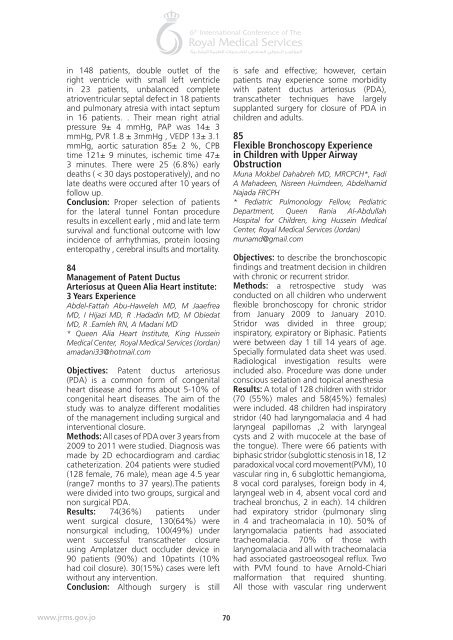Abstract book 6th RMS 16.indd
Abstract book 6th RMS 16.indd
Abstract book 6th RMS 16.indd
You also want an ePaper? Increase the reach of your titles
YUMPU automatically turns print PDFs into web optimized ePapers that Google loves.
in 148 patients, double outlet of the<br />
right ventricle with small left ventricle<br />
in 23 patients, unbalanced complete<br />
atrioventricular septal defect in 18 patients<br />
and pulmonary atresia with intact septum<br />
in 16 patients. . Their mean right atrial<br />
pressure 9± 4 mmHg, PAP was 14± 3<br />
mmHg, PVR 1.8 ± 3mmHg , VEDP 13± 3.1<br />
mmHg, aortic saturation 85± 2 %, CPB<br />
time 121± 9 minutes, ischemic time 47±<br />
3 minutes. There were 25 (6.8%) early<br />
deaths ( < 30 days postoperatively), and no<br />
late deaths were occured after 10 years of<br />
follow up.<br />
Conclusion: Proper selection of patients<br />
for the lateral tunnel Fontan procedure<br />
results in excellent early , mid and late term<br />
survival and functional outcome with low<br />
incidence of arrhythmias, protein loosing<br />
enteropathy , cerebral insults and mortality.<br />
84<br />
Management of Patent Ductus<br />
Arteriosus at Queen Alia Heart institute:<br />
3 Years Experience<br />
Abdel-Fattah Abu-Haweleh MD, M Jaaefrea<br />
MD, I Hijazi MD, R .Hadadin MD, M Obiedat<br />
MD, R .Eamleh RN, A Madani MD<br />
* Queen Alia Heart Institute, King Hussein<br />
Medical Center, Royal Medical Services (Jordan)<br />
amadani33@hotmail.com<br />
Objectives: Patent ductus arteriosus<br />
(PDA) is a common form of congenital<br />
heart disease and forms about 5-10% of<br />
congenital heart diseases. The aim of the<br />
study was to analyze different modalities<br />
of the management including surgical and<br />
interventional closure.<br />
Methods: All cases of PDA over 3 years from<br />
2009 to 2011 were studied. Diagnosis was<br />
made by 2D echocardiogram and cardiac<br />
catheterization. 204 patients were studied<br />
(128 female, 76 male), mean age 4.5 year<br />
(range7 months to 37 years).The patients<br />
were divided into two groups, surgical and<br />
non surgical PDA.<br />
Results: 74(36%) patients under<br />
went surgical closure, 130(64%) were<br />
nonsurgical including, 100(49%) under<br />
went successful transcatheter closure<br />
using Amplatzer duct occluder device in<br />
90 patients (90%) and 10patints (10%<br />
had coil closure). 30(15%) cases were left<br />
without any intervention.<br />
Conclusion: Although surgery is still<br />
is safe and effective; however, certain<br />
patients may experience some morbidity<br />
with patent ductus arteriosus (PDA),<br />
transcatheter techniques have largely<br />
supplanted surgery for closure of PDA in<br />
children and adults.<br />
85<br />
Flexible Bronchoscopy Experience<br />
in Children with Upper Airway<br />
Obstruction<br />
Muna Mokbel Dahabreh MD, MRCPCH*, Fadi<br />
A Mahadeen, Nisreen Huimdeen, Abdelhamid<br />
Najada FRCPH<br />
* Pediatric Pulmonology Fellow, Pediatric<br />
Department, Queen Rania Al-Abdullah<br />
Hospital for Children, king Hussein Medical<br />
Center, Royal Medical Services (Jordan)<br />
munamd@gmail.com<br />
Objectives: to describe the bronchoscopic<br />
findings and treatment decision in children<br />
with chronic or recurrent stridor.<br />
Methods: a retrospective study was<br />
conducted on all children who underwent<br />
flexible bronchoscopy for chronic stridor<br />
from January 2009 to January 2010.<br />
Stridor was divided in three group;<br />
inspiratory, expiratory or Biphasic. Patients<br />
were between day 1 till 14 years of age.<br />
Specially formulated data sheet was used.<br />
Radiological investigation results were<br />
included also. Procedure was done under<br />
conscious sedation and topical anesthesia<br />
Results: A total of 128 children with stridor<br />
(70 (55%) males and 58(45%) females)<br />
were included. 48 children had inspiratory<br />
stridor (40 had laryngomalacia and 4 had<br />
laryngeal papillomas ,2 with laryngeal<br />
cysts and 2 with mucocele at the base of<br />
the tongue). There were 66 patients with<br />
biphasic stridor (subglottic stenosis in18, 12<br />
paradoxical vocal cord movement(PVM), 10<br />
vascular ring in, 6 subglottic hemangioma,<br />
8 vocal cord paralyses, foreign body in 4,<br />
laryngeal web in 4, absent vocal cord and<br />
tracheal bronchus, 2 in each). 14 children<br />
had expiratory stridor (pulmonary sling<br />
in 4 and tracheomalacia in 10). 50% of<br />
laryngomalacia patients had associated<br />
tracheomalacia. 70% of those with<br />
laryngomalacia and all with tracheomalacia<br />
had associated gastroeosogeal reflux. Two<br />
with PVM found to have Arnold-Chiari<br />
malformation that required shunting.<br />
All those with vascular ring underwent<br />
www.jrms.gov.jo<br />
70

















